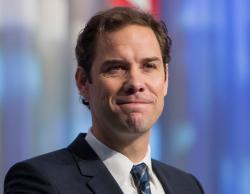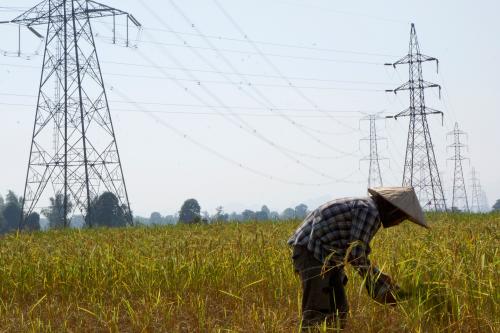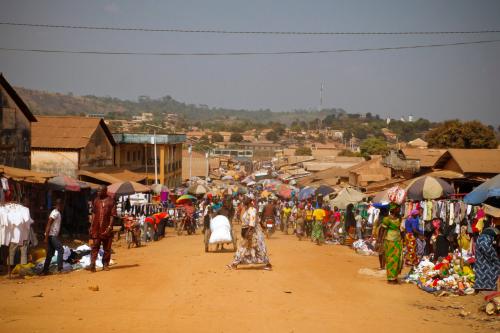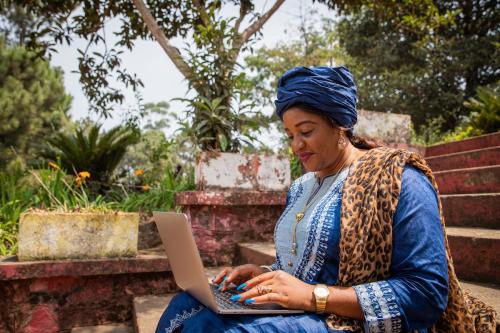The United Nations will convene a major international conference on Financing for Development (FfD) in Addis Ababa, Ethiopia from July 13 to 16, 2015, to discuss financing for the post-2015 agenda on sustainable development. This conference, the third of its kind, will hope to replicate the success of the Monterrey conference in 2002 that has been credited with providing the glue to bind countries to the pursuit of the Millennium Development Goals (MDGs).
The analogy is pertinent but should not be taken too far. The most visible part of the Monterrey Consensus was the commitment by rich countries to “make concrete efforts towards the target of 0.7 percent of gross national product” as official development assistance (ODA). This was anchored in a clear premise that “each country has primary responsibility for its own economic and social development,” which includes support for market-oriented policies that encourage the private sector. While not all of the Monterrey targets have been met, there has been a considerable increase in resources flowing to developing countries, as a central plank of efforts to achieve the MDGs.
Today, aid issues remain pivotal for a significant number of countries, but they are less relevant for an even larger number of countries. The core principles of Monterrey need to be reaffirmed again in 2015, but if the world is to follow-through on a universal sustainable development agenda, it must address the multi-layered financing priorities spanning all countries. A simple “30-30-130” mnemonic helps to illustrate the point. There are 193 U.N. member states. Of these, only around 30 are still low-income countries (33 at the latest count). These are the economies that are, and will continue to be, the most heavily dependent on aid as the world looks to how it should implement the sustainable development goals (SDGs). Conversely, there are only around 30 “donor” countries (including 28 members of the OECD Development Assistance Committee, or DAC) that have made international commitments to provide more aid. For the remaining 130 or so emerging middle-income economies that have achieved higher levels of average prosperity, aid discussions risk forming a sideshow to the real issues that constrain their pursuit of sustainable development. The bottom line is that for most countries, the Financing for Development conference should unlock finance from many different sources, including but not exclusively aid, to implement the SDGs.
Addis will take place in the context of sluggish global growth, an upsurge in conflict, considerable strains in multilateral 2 political cooperation, and challenging ODA prospects in many countries.
There are other differences between Addis and Monterrey. Monterrey took place after agreement had been reached on the MDGs, while Addis will precede formal agreement on the SDGs by a few months. Monterrey was focused on a government-to-government agreement, while Addis should be relevant to a far larger number of stakeholders—including businesses, academics, civil society, scientists, and local authorities. Monterrey was held against a backdrop of general optimism about the global economy and widespread desire for intensified international collaboration following the terrorist events of September 11, 2001. Meanwhile, Addis will take place in the context of sluggish global growth, an upsurge in conflict, considerable strains in multilateral
political cooperation, and challenging ODA prospects in many countries. In addition, regulators are working to reduce risk-taking by large financial institutions, increasing the costs of providing long-term capital to developing countries.
Against this backdrop, an Intergovernmental Committee of Experts on Sustainable Development Finance (ICESDF) crafted a report for the United Nations on financing options for sustainable development. The report provides an excellent overview of issues and the current state of global financing, and presents over 100 recommendations. But it falls short on prescribing the most important priorities and action steps on which leaders should focus at Addis.
This paper seeks to identify such a priority list of actions, with emphasis on the near-term deliverables that could instigate critical changes in trajectories towards 2030. At the same time, the paper does not aim to describe the full range of outcomes that need to be in place by roughly 2025 in order to achieve the SDGs by their likely deadline of 2030. Addis will be a critical forum to provide political momentum to a few of the many useful efforts already underway on improving global development finance. Time is short, so there is limited ability to introduce new topics or ideas or to build consensus where none already exists.
We identify three criteria for identifying top priorities for agreement in Addis:
- Priorities should draw from, and build on, on-going work—including the ICESDF report and the outputs of several other international workstreams on finance that are underway.
- Agreements should have significant consequences for successful implementation of the SDGs at the country, regional or global level.
- Recommendations should be clearly actionable, with next steps in implementation that are easy to understand and easy to confirm when completed.
It is not necessary (or desirable) that every important topic be resolved in Addis. In practical terms, negotiators face two groups of issues. First are those on which solutions can be negotiated in time for the July conference. Second are those for which the problems are too complex to be solved by July, but which are still crucial to be resolved over the coming year or two if the SDGs are to be achieved. For this second group of issues, the intergovernmental agreement can set specific timetables for resolving each problem at hand. There is some precedent for this, including in the 2005 U.N. World Summit, which included timetables for some commitments. What is most critical is that the moment be used to anchor and advance processes that will shift toward creating a global financing system for achieving sustainable development across all countries. Committing to timetables for action and building on reforms already undertaken could be important ways of enhancing the credibility of new agreements.
In this paper, we lay out nine areas where we believe important progress can be made. In each area, we start from identifying a gap or issue that could present an obstacle to the successful implementation of the SDGs if left unattended. In some cases the gaps will affect all countries, in other cases only a subset of countries. But we believe that the package of actions, taken as a whole, reflects a balance of opportunities, responsibilities and benefits for all countries. We also believe that by making the discussion issue-focused, the needs for financing can be balanced with policy actions that will be required to make sure financing is effectively and efficiently deployed.
In addition to the nine areas listed below, there are other commitments already made which have not yet been met. We urge renewed efforts to meet these commitments, but also recognize that political and financial realities must be managed to make progress. Such commitments include meeting the Monterrey Consensus target to provide 0.7 percent of GNI in official development assistance (ODA), the May 2005 agreement of all EC-15 countries to reach that target by 2015, and bringing the Doha Development Round of trade talks to a successful conclusion. These remain important and relevant, but in this paper we choose to focus on new areas and fresh ideas so as to avoid treading over well-worn territory again.








